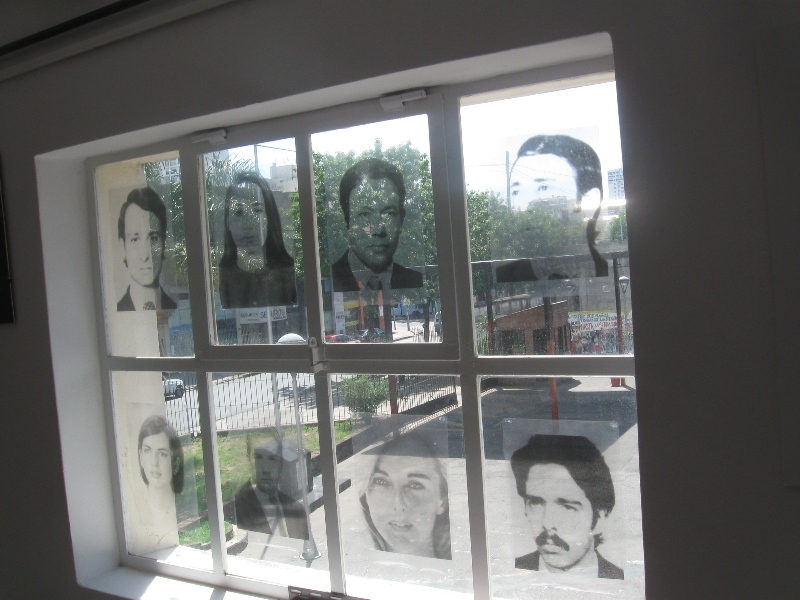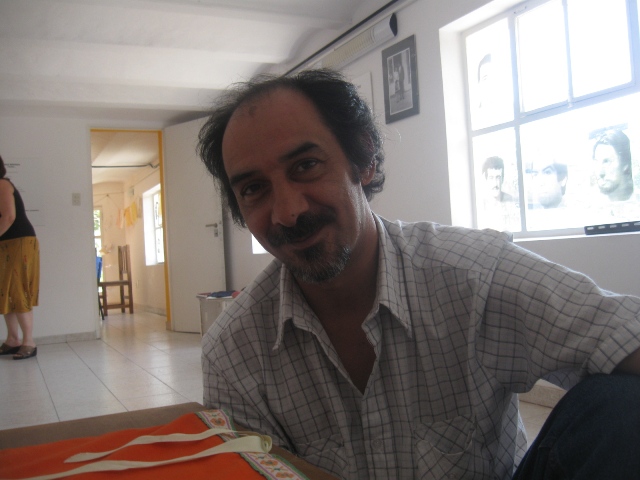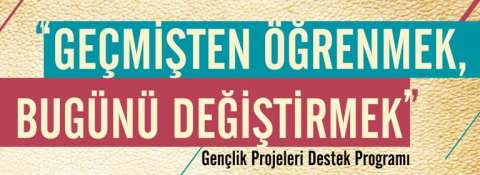Interview by Canan Kaya
Buenos Aires
Although I have been living in Buenos Aires for years, I was surprised to learn that Olimpo, which I had not gone to because it seemed far, is actually quite close to the city center. Later, I realized that except for ESMA, The Navy Mechanics School, all the torture centers of the dictatorial era were purposefully placed in middle class and lower middle class neighborhoods. What is unique about Olimpo, along with Mansion Sere, is that unlike other centers, it had been transformed entirely into a torture and rehabilitation center. Olimpo had been transformed from a municipality bus station into a concentration camp and torture center, while other centers were already army or police quarters. When Club Atletico, the other torture center near Boca, was torn down for highway construction, the prisoners were transferred to Olimpo. Only 50 of the 700 prisoners who were transferred to Olimpo, “operational” for only six months between 1978 and 1979, survived.
Olimpo’s coordinators Maria Eugenia Mendizabal and Ricardo Maggio were guests of the Memorialisation Workshop held in Istanbul in December. We spoke to Maria Eugenia and Ricardo about their İstanbul visit.
What question surprised you the most during your visit to İstanbul?

Maria Eugenia: When we met with comrades from Turkey, one of them, I think her name was Özgür, asked “what do the people who come to visit you say when they see communist symbols on the booklets you prepared in the memory of those killed at Olimpo? Don’t they object?” This was one of the questions that surprised me the most. I told him we were over such things now and people were more tolerant and did not care about this stuff.
What was the first picture that caught your eye in İstanbul?
Maria Eugenia: What I saw in İstanbul the first day was a picture of modernity. Let me explain this picture as follows: On the one side city lights, shopping malls, fancy avenues, and on the other side covered women, mosques, bazaars, people constantly shopping. You don’t see the state violence at first glance, because it is invisible. At the outset, unless somebody tells you; somebody says people are taken into custody, maltreated, arrested, it is not really possible for you to notice it. If my friends there had not told me about what was deemed appropriate for Kurdish people, intellectuals, journalists and students, I could have only made general observations like any tourist coming to İstanbul. And despite everything my friends told me, we only began to understand what was happening in Turkey at the Memorials, Monuments and Museums Workshop.
What trail did you follow to understand what was happening in Turkey?
Maria Eugenia: “What should be the starting point of memory work regarding the aggrieved of the dictatorial era, the dissidents, communists and what is being done to the Kurdish people and the ongoing state terror?” This question was our guide for understanding Turkey. Because while on the one hand former political prisoners feel the need to talk about what they have been through, on the other the terror they were subject to continues for other people today. Therefore creating the memory of the past or the present will also simultaneously pave the way for the rehabilitation of the other. That is to say, in Turkey it is not possible to assert “horrible things happened in the past military coup era and now everything is a bed of roses.” Oppression still continues. Creating the memory of the current conflict will retrieve the memory of the old conflict, or vice versa.
Another observation I made was the constant traffic of police cars on that famous street; İstiklal Street. People were scared, yet at the same time many young people were strolling down the street, having fun. People seemed to be used to having the police around there despite their fear. It is not easy to notice this situation unless you look closely. When you look from the outside it appears as if people are laughing, having a good time despite the police, but as you slowly get to know them, you understand their fears.

When we began to listen to the testimonies of Kurdish political prisoners, we got the chance to compare their experiences with what we have been through. Kurdish people are not only subject to state terror; the surviving prisoners are also subject to exclusion policies. They were all alone. On one side, you have the Kurdish militants and the Kurdish people; on the other, the masses who don’t want to hear them or know what they are going through. The same thing happened here.
Here, I mean at the Olimpo Garage and other torture centers in the city, when we ask those who lived nearby “Did you not notice what was happening at all, how did you not understand?”, some say, “yes, we realized it,” and others “no, we weren’t aware at all.” Actually what happened was that to a large extent the society had accepted state terror. Some out of fear and others because they supported it.
In Turkey the exclusion of Kurds is grounded in a more racist framework. Because the official ideology claims that the only language is Turkish, a Kurdish person will be more accepted if s/he assimilates; that is, becomes more Turkish, and revokes his/her Kurdish identity. Otherwise he or she is no one.
Maria Eugenia: The Republic of Turkey was founded at the beginning of the 20th century. Argentina became a state in the 19th century, nearly a century before Turkey. Therefore, we don’t really witness the violence and genocide of the natives here in the 20th century, because by the end of the 1900s they slaughtered nearly all of them anyway. Here state terror happened in stages. As far as I understand in Turkey it happened all at once. First the Armenians, then the deportation of Greeks, at the same time the conflict with the Kurds, massacres, followed by consecutive dictatorships; all of these were experienced simultaneously in the process of forming a nation state. This has consequently created a massive cycle of violence.
When we were there, I heard the speech of the Minister of the Interior declaring everyone a terrorist. Artists, intellectuals, they are all terrorists, he said. At that point I thought, “can the state constantly create new categories of violence and can it become more and more difficult for the public to see this each time?”
What do you think about our Saturday Mothers? What are their similarities with or differences from the mothers here?
Maria Eugenia: We went to the demonstration of Saturday Mothers. They were demonstrating at a sit in on the busiest street of İstanbul. We walked to Galatasaray from Taksim Square, where there is an Atatürk monument. Taksim Square is a square full of various symbols. Imagine that street begins with those symbols and ends with the mothers. I think this has a symbolic significance. Just as the statue symbolizes how this state exists, I think the mothers symbolize what that state can inflict. And in the middle is capitalism. A glittering street, shopping malls, world-renowned brands, etc.
You had heard about the Saturday Mothers before, right?
Maria Eugenia: We knew of their existence but to be honest we did not know much about their struggle.
At this point Ricardo joins us. Maria tells me that Ricardo has been a part of the memory and justice movement since he was very young… In the first years of the Plaza de Mayo Mothers organizing, when he was only 15, he was together with the mothers. Ricardo likens the state of the Saturday Mothers to the early years of the Plaza de Mayo Mothers and comments that they are yet very new and very much alone.
Saturday Mothers’ struggle began in 1995. From then on, for three years, they met each week without fail and were constantly subject to violence. In the meantime, due to numerous reasons such as political developments in the country, hunger strikes, the 19 December massacre, the mothers discontinued their demonstrations for a while, but they have resumed in recent years.

Ricardo: Here, when the demonstrations of the mothers started, they seized the opportunity to make their voices heard throughout the world both during the World Cup and on other occasions. The fact that Argentina was comprised of European immigrants and their ties with Europe made it easier. The mothers were able to get in touch with many European journalists, politicians and human rights organization representatives. Following the coup and in the 1980s social democracy was quite strong in Europe. Mothers were able to talk to Mitterrand, to Olof Palme. So they were able to make themselves heard at the international level. In the case of the Saturday Mothers, I see exclusion and isolation at the international level. Unfortunately, there is no international organization that will support the struggle of the Mothers against the State of Turkey. I also think the fact that the Kurdish people have not been able to establish a strong resistance force in support of the mothers’ struggle with progressive, socialist, and democrat Turkish groups has also forestalled their voices being heard internationally. They could not use their advantage in Germany, which is the country with the largest Turkish population after Turkey.
At the same time, Turkey’s relationship with the USA and its military alliance with Western states due to its NATO membership may have also transformed into international barriers for the Mothers.
Maria Eugenia: It seems to me that while the global public knows more or less what is going on in Turkey, the general assumption might be that despite their oppressive policies, the governments, elected and reelected again and again, are generally accepted. The people elected this government. I mean, it is not something imposed top down. It is not the same thing with a dictatorship. The majority of the people have elected this government even though they are well aware of it oppressive policies, or even because they want these policies to continue. Therefore what is happening in Turkey is very different than what has happened here, and it is difficult to compare. The government here executed all its oppressive policies with dictatorship laws and the military coup constitution. What is going on in Turkey is almost identical, but these people have been elected to power. Dictatorship in Turkey continues through democratic means. This also means the legitimization of dictatorship.
Ricardo: In Argentina the dictatorship had oppressed all opposition, all movements, the church, democratic mass movements, unions, etc.; but both the oppressor and the oppressed were Argentinian. As for Turkey, there is an ongoing war with the Kurdish. The State is able to disguise effortlessly what is happening with the Kurdish separatists with the makeup of war. It easily legitimizes oppression and massacres by claiming they are fighting with the PKK. A struggle with this oppression, however, is only possible through constant exposure. Success can only be attained through the struggle for human rights, through museums of memory, through introducing artists and filmmakers like Veysi Altay to the world, through developing close ties with human rights organizations, and through the relentless and continuous uncovering of what has happened.
How much are the Argentinians aware of the Mothers’ efforts?
Ricardo: To tell you the truth people here do not know what is happening in Turkey. Many people anyway think the Turks are part of the Arab world. They don’t even know who Kurdish people are. Distance and localism in a sense kill solidarity.
Maria Eugenia: Until they are faced with the truth, people think atrocities can’t affect them. Here also, though not as intensely and horrifically as in your country, there are developments we find disturbing. For instance, recently the anti-terror law was passed. Even though it is difficult for it to be enforced in and around Buenos Aires for now, it is being enforced in Catmarca. Those who opposed mining were its first victims. For now the government is giving a guarantee, but in case of any change in administration or a situation conflicting with the government interests, the law can be enforced everywhere. This is what we are trying to explain to people now. If you close your eyes you’ll see nothing. When we were in İstanbul the new year was approaching. While the majority was happily walking around the street shopping, some were in anxiety and fear. Because their friends were taken into custody, arrested, expelled from university, their houses raided. In such a situation only academia, artists, students, journalists can render the oppression visible. Yet what I saw was the abandonment and loneliness of the Mothers. Just like the photographs on the laps, sorrowful… Just like it was here in ’78…
Apart from the Mothers’ struggle, what sort of observations did you make regarding daily life in Turkey?
Ricardo: Actually, we only stayed at the city center. We did not have the chance to go around İstanbul and observe life. We only visited touristic places. But it was not possible to understand anything if you simply look from the outside. People were at their shopping, leisure, entertainment. That is why I compare it to the state of Argentina in ’78. Swarming with the police and the constant sound of sirens. One of my observations about İstanbul was the visibility of the prostitution mafia, which seemed to be a massive organization. There were nightclubs close to the place we stayed at; there was incredible human trafficking.
Maria Eugenia: Also we saw many little girls—or, let’s say, young girls—with elderly men, much, much older than themselves. There were young girls of 20-25 beside men of 60-65, it was very strange.
Ricardo: When we went to the demonstration, it surprised us that in addition to the uniformed police immediately surrounding us, there were so many plainclothes police as well. As we were walking one of them had pinned a young boy to a wall, frisk searching him, people were passing by as if nothing was happening, no one was reacting.
Maria Eugenia: I grew a bit uneasy after understanding the state oppression and police violence in İstanbul. I was a little scared when my partner went outside the hotel to smoke early in the morning.
Ricardo: It is normal for fear to emerge in an environment where people’s houses are being raided; where they are being taken to police stations. Of course we are foreigners, what we witnessed in a country we did not know made us more edgy. You are in a foreign country, erotic night clubs are two steps down the road, constant police sirens and police radios, I mean, it’s strange. All of these are means to control society.
Maria Eugenia: If İstanbul is like this, I can’t even imagine what it is like there. What do people do there?
The people there are more accustomed to this, because they’ve never had normal circumstances. Martial law, the September 12 coup, state of emergency…
Maria Eugenia: They have been able to mobilize public support for the oppression and policies and practice of violence… And what’s more, it has been like this for 30 years. How can an environment of violence be sustained for 30 years? How can people be made accustomed to the constant killing of people? The creation of the nation-state in Turkey has brought ethnic cleansing alongside it. One language, one flag, religious unity. Unfortunately the majority of the Turkish people are nationalists. That is why everyone is happy with Erdoğan, why Atatürk can still be a symbol of heroism.
What parallels are there between the Argentinian Mothers and the Mothers in Turkey?
Maria Eugenia: They share a common object; the headscarf. The story of the headscarves. I mean, this is something traditional. Women in Turkey traditionally use these scarves. Here it is the same. Actually these scarves, these pieces of cloth facilitate the continuation of the family’s story. As women, we are responsible for the transmission of culture, everyday life and the legacy of countless other things. We transmit many things like child nappies, sheets, lace to the next generation. These might seem trivial, but these trivial things are what will reconstruct history and culture. Same stories may be woven here and there. Here, many comrades wear the keffiyeh worn by Palestinians and the Kurdish people. These cloths, mothers’ headscarves and the keffiyeh, are objects with the capacity to spread the struggle and transmit it to future generations.
What we have to realize here is that these symbols don’t only symbolize the struggle against state terror but also the struggle we embark on in all spheres of life. Justice is not the only demand of the mothers. For example, the Plaza de Mayo Mothers Foundation, under the leadership of Hebe de Bonafini, also work in poor neighborhoods in addition to their constant demand for justice and toil so that children are not left hungry. I would guess that those people who stand by the Mothers in Turkey are also struggling not only to expose the violence experienced and ensure that it is not repeated, but also so that no child goes hungry, all children can be warm and go to school.



